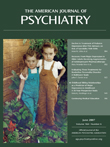Dr. Milrod Replies
To The Editor: In clinical medicine, mechanisms of action are often opaque. Because we have yet to (may never, in fact) fully answer questions concerning mechanisms of effective treatments, should we avoid these treatments? To do so would be irresponsible, since these treatments have demonstrated efficacy from which patients should benefit. The late Gerald L. Klerman emphasized the primacy of outcome, pointing out that if a therapy lacks clinical benefit, its mechanism holds little interest (1) . Our study demonstrated the efficacy of panic-focused psychodynamic psychotherapy for the treatment of panic disorder. It should not be confused with a study of mechanism, something we never claimed. The CBT model of treatment, whether scientifically sound or not, is irrelevant to the psychoanalytic model. Often, in the treatment of complex illnesses such as psychiatric disorders, more than one model can be useful—as Dr. McKay et al. note for depression.
Our study was more rigorously conducted than many oft-cited psychotherapy outcome studies, and this was demonstrated in its control and tracking of non-study interventions such as medications, which can blur apparent psychotherapy outcome, and in its maintenance of two levels of blindedness among independent evaluators (who were blinded to patient and therapist orientation) (2) . Furthermore, our study has been prescient in evaluating the moderator effect of axis II pathology on panic outcome (3) . No one should be blinded by ideology (4) , a risk that cognitive theorists now face as much as psychoanalysts have in the past.
Without the equivalent of a pharmaceutical industry to provide financial backing, psychotherapy researchers must battle one another for ever-shrinking federal funds. A step forward for psychodynamic psychotherapy should not be a defeat for CBT. This has become as much of a “guild war” as any. In both cases, it is in our patients’ best interest that the field remains open to and accepting of a range of treatment approaches.
1. Klerman GL: Ideological conflicts in integrating pharmacotherapy and psychotherapy, in Integrating Pharmacotherapy and Psychotherapy. Edited by Beitman BD, Klerman GL. Washington, DC, American Psychiatric Publishing, 1991Google Scholar
2. Milrod B, Busch F: The long-term outcome of treatments for panic disorder: a review of the literature. J Nerv Ment Dis 1996; 184:723–730Google Scholar
3. Milrod B, Leon AC, Barber JP, Markowitz JC, Graf E: Do comorbid personality disorders moderate panic-focused psychotherapy?: an exploratory examination of the APA Practice Guideline. J Clin Psychiatry (in press)Google Scholar
4. Markowitz JC: Interpersonal psychotherapy, in American Psychiatric Publishing Textbook of Clinical Psychiatry, 4th ed. Edited by Hales RE, Yudofsky SC. Washington, DC, American Psychiatric Publishing, 2003, pp. 1207–1223Google Scholar



